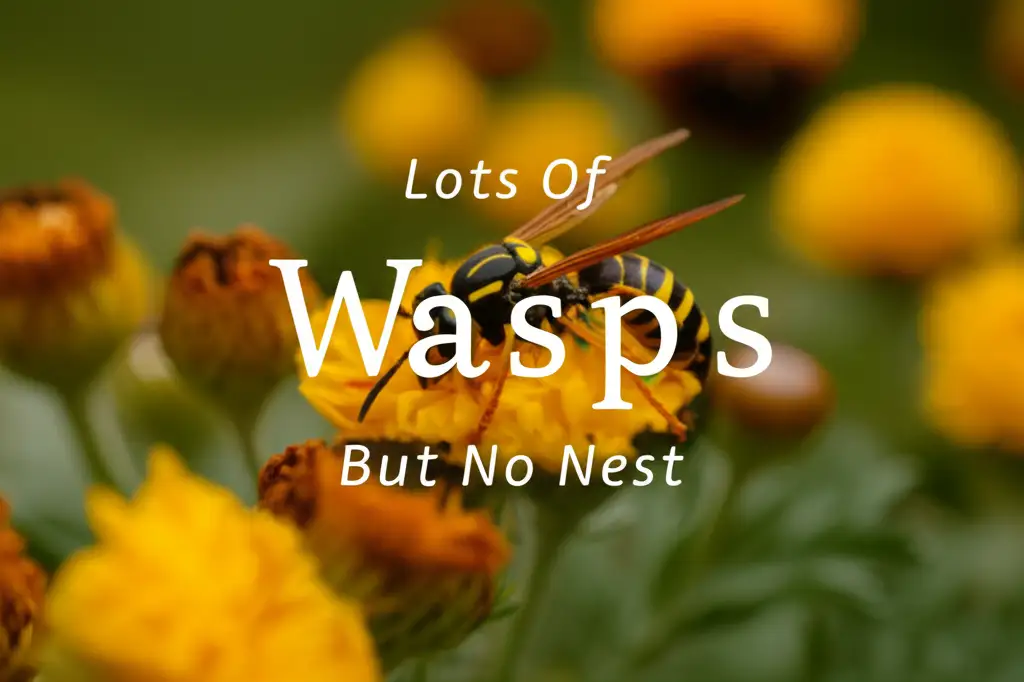· Tessa Winslow · Home Maintenance · 13 min read
Lots Of Wasps But No Nest

Lots Of Wasps But No Nest: Finding The Source
Have you ever stepped outside and seen a flurry of wasps, buzzing around your yard, but found no visible nest? It can be a confusing and concerning sight. You might wonder where they all come from. This situation, where you observe lots of wasps but no nest, is actually common.
These insects are industrious creatures, always busy with their tasks. Their nests are often very well hidden, making them difficult to spot. This guide will help you understand why you see so many wasps. We will show you where they might be hiding. You will also learn how to manage their presence safely around your home. Let’s find out what is going on with these uninvited buzzing guests.
Takeaway
When you see lots of wasps but no nest, consider these points:
- Hidden Nests: Wasps often build nests in secluded or hard-to-see places.
- Foraging Activity: Individual wasps might be scouting for food or materials.
- Neighbor’s Nests: Wasps from a nearby property can fly into your yard.
- Scout Wasps: Single wasps are often looking for new nesting sites.
- Attractants: Food, water, or sweet smells draw wasps to your area.
Why do I see lots of wasps but no nest around my home?
You likely see many wasps because a nest is hidden nearby, or they are foraging for food and water. They might also come from a neighbor’s property. Scout wasps look for new places, and food sources attract many wasps.
Understanding Wasp Behavior Without A Visible Nest
It feels strange to see lots of wasps but no nest. You might think they just appear out of nowhere. However, wasps always have a home, even if you cannot see it. This behavior means a nest is often very close. Wasps are always busy. They fly far from their nest to find food, water, and building materials.
Single wasps often act as scouts. These scouts search for new food sources or good places to start a new colony. If you see only a few wasps flying randomly, they might just be passing through. But if you see a constant stream of wasps, they are likely going to and from a nearby nest. This hidden nest could be on your property or a neighbor’s property. Understanding this helps you look for the nest in the right places.
Why Wasps Hide Their Nests So Well
Wasps build nests in safe, protected spots. These spots keep the nest safe from predators and bad weather. They often choose dark, quiet places. This makes them hard for people to find. A nest may be in a wall void, under eaves, or in dense bushes. We often miss these spots on a quick look. Their nest material often blends into the background. This makes the nest even harder to spot. They do not want you to find their home easily.
Common Hidden Locations For Wasp Nests
Finding lots of wasps but no nest means you need to think like a wasp. Wasps choose places that offer shelter and security. Their nests can be almost anywhere. Knowing their favorite spots helps you locate the hidden nest. These locations often provide warmth and protection from rain.
- Wall Voids: Wasps can enter through small cracks or gaps in your home’s exterior. They build nests inside wall cavities. You might hear buzzing sounds inside the walls. This is a common place for yellowjacket nests.
- Attics and Roof Spaces: These areas are warm and undisturbed. Wasps find entry points through roof vents or loose fascia boards. Check the corners and rafters. Sometimes, they even use unused chimneys. This is a very common hidden spot. You might need to check your how to clean a ceiling space for signs of entry.
- Under Eaves and Soffits: Wasps often attach their nests to the underside of roof overhangs. They also use the soffits. These spots offer rain protection. Look closely at all edges of your roof.
- Ground Nests: Some wasp species, like yellowjackets, build nests underground. They use old rodent burrows or natural holes. You might see wasps flying in and out of a specific hole in your lawn or garden. Be careful when cleaning outdoor spaces like a how to clean concrete sidewalk nearby, as you might disturb them.
- Sheds and Outbuildings: Unused sheds, garages, or even children’s playhouses offer good shelter. Check the rafters, corners, and inside any stored items. These places are often undisturbed for long periods.
- Dense Bushes and Trees: Wasps can build nests in thick shrubbery or tree branches. The foliage provides excellent camouflage. Carefully inspect dense foliage around your home.
- Patio Furniture and Outdoor Structures: Sometimes, wasps attach small nests to the underside of patio tables or benches. They also use barbecue grills or unused planters. Always check your how to clean plastic patio furniture before use.
Identifying Different Wasp Species And Their Nesting Habits
When you see lots of wasps but no nest, knowing the wasp species helps. Different wasps have different nesting habits. This knowledge helps you narrow down where to look. Some wasps prefer open areas, while others like hidden spots.
- Yellowjackets: These are common and aggressive wasps. They have bright yellow and black stripes. They build large nests, often hidden in wall voids, underground burrows, or dense shrubs. Their nests are made of paper-like material. They are scavengers and often visit picnics or garbage cans.
- Paper Wasps: These wasps are usually slender, with a darker brown or reddish-brown color. They build umbrella-shaped nests. They hang their nests from eaves, tree branches, or porch ceilings. The nest has visible open cells. You can see the larvae inside.
- Hornets: Hornets are larger than other wasps. They are often black and white (baldfaced hornets) or yellow and black (European hornets). Baldfaced hornets build large, gray, football-shaped nests in trees or bushes. European hornets often nest in hollow trees, attics, or wall voids. Their nests are also paper-like.
Knowing the type of wasp helps you understand its usual nesting sites. This makes finding the hidden nest easier. Each species has its preferred building location. This helps you focus your search.
Signs Of A Nearby Hidden Wasp Nest
Seeing lots of wasps but no nest is the first sign. But other clues can point to a hidden nest. Observing wasp behavior carefully can reveal their secret home. Look for patterns in their flights.
- Consistent Flight Paths: Wasps usually fly in a straight line to and from their nest. Watch their flight direction. If you see many wasps flying in and out of a specific spot, like a crack in a wall or a hole in the ground, that is likely the nest entrance. They will follow this path repeatedly.
- Increased Activity: You will see more wasps around. This is especially true during warmer parts of the day. If activity increases in a specific area, a nest is likely very close. They become very busy during peak season.
- Buzzing Sounds: If a nest is in a wall void or attic, you might hear a buzzing or scratching sound. This sound comes from the many wasps moving inside the hidden space. Listen closely near walls, ceilings, or attics. You may even consider checking your how to clean air vents as wasps could try to use these entry points.
- Debris Around an Opening: Wasps chew wood and other materials to build their nests. You might see small piles of wood shavings or paper-like debris near a hidden entry point. This indicates they are building a nest inside.
- Aggressive Behavior: If wasps become aggressive without being provoked, you are too close to their nest. They are defending their home. This is a clear warning sign. They will sting if they feel threatened.
These signs help confirm a hidden nest is present. Do not ignore them. Take action carefully once you identify the potential location.
Safe Steps For Managing Wasp Activity And Hidden Nests
Dealing with lots of wasps but no nest requires a careful approach. Your safety is most important. Do not try to remove a large nest yourself. Professional help is often the best choice.
- Observe From a Distance: First, watch the wasps from a safe distance. Try to confirm their flight path. Note where they enter or exit. Do not get too close.
- Identify Entry Points: Look for cracks, holes, or gaps. These are often where wasps go in and out. This helps you confirm the nest location. Check areas like the foundation or loose siding.
- Reduce Attractants: Wasps are drawn to food and sugar. Keep garbage cans tightly sealed. Clean up spills immediately. Do not leave pet food outdoors. Clean your outdoor dining areas, including your how to clean the refrigerator inside and out, if it’s an outdoor unit, to prevent attracting them.
- Store ripe fruits indoors.
- Cover sugary drinks when outside.
- Empty outdoor trash cans often.
- Use Wasp Traps (For Scouting Wasps): Commercial wasp traps can help catch individual foraging wasps. Place them away from your main living areas. This can reduce the number of wasps buzzing around. These traps are not effective for a hidden nest.
- Seal Small Gaps (Preventative): Seal any small cracks or holes in your home’s exterior. Do this when wasp activity is low. This prevents wasps from entering wall voids later. Use caulk or mesh screen.
- Professional Pest Control: If you find a large hidden nest, call a pest control professional. They have the right equipment and knowledge. They can remove the nest safely. Trying to remove a large nest yourself can be dangerous. Wasps will sting to defend their colony.
Remember, act calmly. Do not swat at wasps, as this makes them more aggressive. Call an expert for large or hard-to-reach nests.
Preventing Future Wasp Problems Around Your Home
After dealing with lots of wasps but no nest, you want to prevent them from returning. Prevention is better than removal. A few simple steps can make your home less inviting to wasps. Make your yard an unfriendly place for them.
- Seal Entry Points: Inspect your home’s exterior for cracks, holes, or gaps. Seal these with caulk, expanding foam, or mesh. Pay attention to vents, eaves, and foundation cracks. This stops wasps from building nests inside your walls or attic.
- Maintain Your Yard: Keep your lawn mowed short. Trim dense bushes and trees. Remove any piles of debris or firewood. These can be good hiding spots for nests. A clean yard gives wasps fewer places to build.
- Proper Waste Management: Keep all trash cans tightly sealed. Use lids that wasps cannot easily lift. Clean garbage bins regularly. This removes food sources that attract wasps.
- Limit Outdoor Food Sources: Clean up food spills immediately after outdoor meals. Bring pet food bowls inside. Keep sugary drinks covered. Wasps love sweet things.
- Install Screens: Ensure all windows and doors have well-maintained screens. Repair any tears. This keeps wasps from entering your home.
- Consider Wasp Deterrents: Some people use fake nests to deter wasps. Wasps are territorial and avoid building near another colony. These are not always 100% effective, but can help.
- Regular Inspections: Periodically check common nesting spots. Look under eaves, in sheds, and around outdoor structures. Catching a small nest early makes removal easier.
By being proactive, you can greatly reduce the chances of wasps taking up residence near your living space. A little effort now saves a lot of trouble later.
Myths and Facts About Wasp Activity
When you deal with lots of wasps but no nest, you might hear many ideas. It is good to know what is true and what is not. This helps you react properly to wasp sightings.
- Myth: Wasps are always aggressive.
- Fact: Wasps are only aggressive when they feel threatened or when their nest is disturbed. Foraging wasps usually ignore people. They attack to defend their home. Do not swat at them.
- Myth: All wasps build paper nests.
- Fact: Many wasps build paper nests. But some, like certain yellowjackets, build nests underground. Others may nest in wall voids or hollow trees. Their nest material varies slightly.
- Myth: Wasps only sting once and then die.
- Fact: Unlike honey bees, most wasps can sting multiple times without dying. Their stingers do not detach. This makes them more dangerous if you disturb a nest.
- Myth: Killing individual wasps solves the problem.
- Fact: Killing a few wasps will not remove a hidden nest. More wasps will just come out. It might even make the remaining wasps more agitated. You need to find and address the nest.
- Myth: Wasps are completely useless insects.
- Fact: Wasps play a role in the ecosystem. They are predators of other insects, like caterpillars and flies. This helps control garden pests. Some wasps also act as pollinators. They are not entirely bad.
Understanding these facts helps you manage wasp situations more effectively. It also promotes respect for their role in nature.
Frequently Asked Questions About Wasps
Q1: What does it mean if I see one wasp repeatedly in my house?
If you see a single wasp often inside your house, it might be a scout looking for a new nesting site. It could also mean a very small, new nest is nearby. Or, it might be a straggler from an outdoor nest. Try to catch and release it outside.
Q2: Can wasps build a nest inside a wall without me seeing an entry point?
Yes, wasps can build nests inside walls. They enter through very small cracks or gaps. These entry points can be hard to spot. You might not see the entry hole, but the nest is there. Listen for buzzing sounds inside the wall.
Q3: How long does a wasp nest last?
Most wasp nests, especially those built by common species like yellowjackets and paper wasps, are annual. They are active for one season. The queen starts a new nest each spring. The old nest will not be reused.
Q4: Are ground nests more dangerous than aerial nests?
Ground nests, often made by yellowjackets, can be more dangerous. People often step on them without knowing. This disturbs the wasps immediately. Aerial nests are usually more visible. Both types of nests pose a threat if disturbed.
Q5: Can I use natural repellents to get rid of wasps?
Some natural repellents like peppermint oil, citronella, or clove oil may deter wasps in small areas. They are not effective for removing an existing nest or controlling a large wasp problem. Use them for minor prevention.
Q6: When is the best time to look for a hidden wasp nest?
The best time to look for a hidden wasp nest is during the day when wasps are most active. This makes their flight paths visible. Early morning or late evening, when activity is lower, can be safer for a closer inspection, but also harder to spot the wasps.
Conclusion
Seeing lots of wasps but no nest can be alarming. Remember, a hidden nest is almost always the reason. Wasps are clever builders. They choose spots that keep their homes safe and out of sight. By understanding wasp behavior, you can locate these hidden nests. This includes knowing their preferred hiding spots and observing their flight patterns.
It is important to act with caution. Do not disturb a suspected nest without proper protection. Always prioritize your safety. If you find a large or active nest, calling a professional pest control service is the smartest move. They have the tools and experience to handle the situation safely. By taking preventative measures, like sealing gaps and keeping your yard clean, you can make your home less attractive to wasps. Stay proactive. This helps ensure a safer, more enjoyable home environment for everyone.





